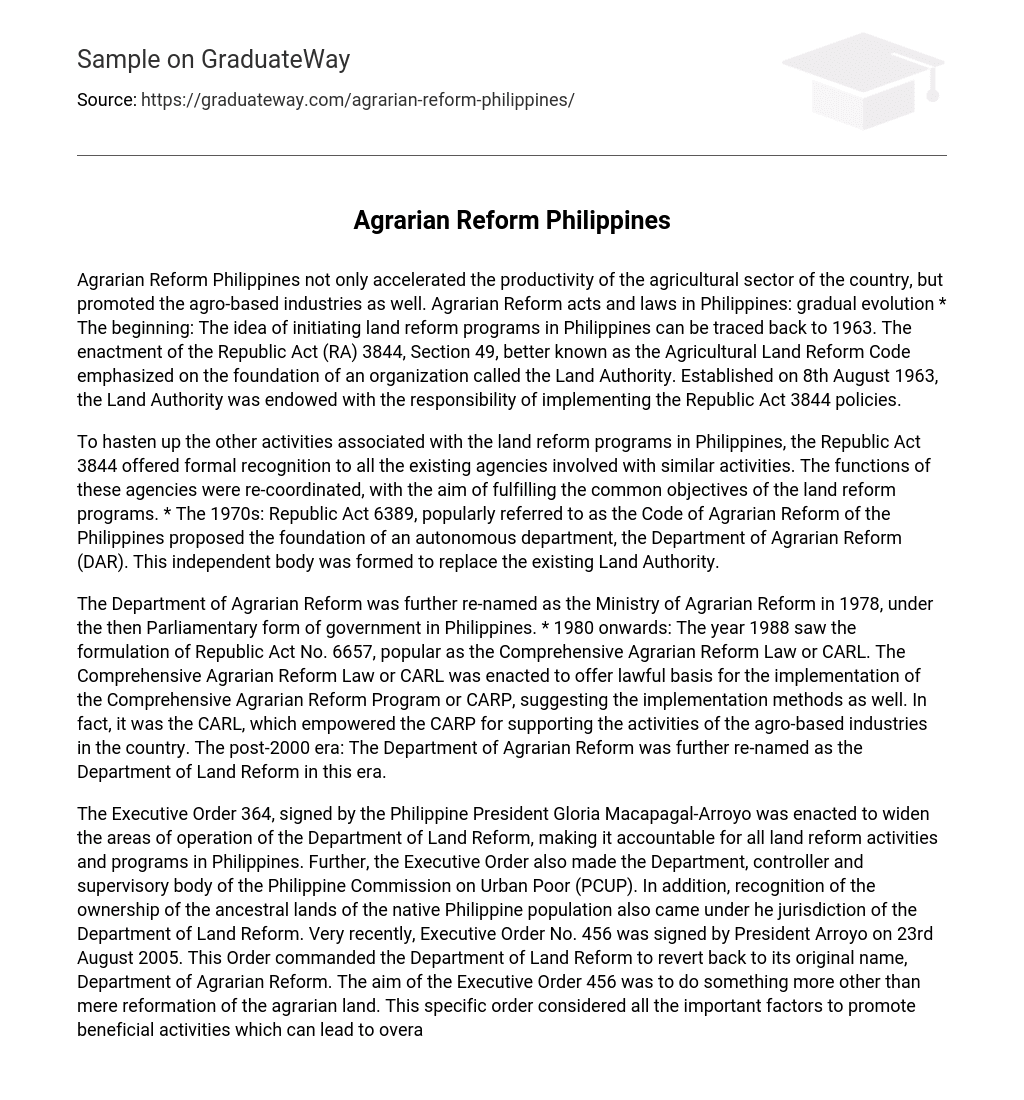Agrarian Reform Philippines not only accelerated the productivity of the agricultural sector of the country, but promoted the agro-based industries as well. Agrarian Reform acts and laws in Philippines: gradual evolution * The beginning: The idea of initiating land reform programs in Philippines can be traced back to 1963. The enactment of the Republic Act (RA) 3844, Section 49, better known as the Agricultural Land Reform Code emphasized on the foundation of an organization called the Land Authority. Established on 8th August 1963, the Land Authority was endowed with the responsibility of implementing the Republic Act 3844 policies.
To hasten up the other activities associated with the land reform programs in Philippines, the Republic Act 3844 offered formal recognition to all the existing agencies involved with similar activities. The functions of these agencies were re-coordinated, with the aim of fulfilling the common objectives of the land reform programs. * The 1970s: Republic Act 6389, popularly referred to as the Code of Agrarian Reform of the Philippines proposed the foundation of an autonomous department, the Department of Agrarian Reform (DAR). This independent body was formed to replace the existing Land Authority.
The Department of Agrarian Reform was further re-named as the Ministry of Agrarian Reform in 1978, under the then Parliamentary form of government in Philippines. * 1980 onwards: The year 1988 saw the formulation of Republic Act No. 6657, popular as the Comprehensive Agrarian Reform Law or CARL. The Comprehensive Agrarian Reform Law or CARL was enacted to offer lawful basis for the implementation of the Comprehensive Agrarian Reform Program or CARP, suggesting the implementation methods as well. In fact, it was the CARL, which empowered the CARP for supporting the activities of the agro-based industries in the country. The post-2000 era: The Department of Agrarian Reform was further re-named as the Department of Land Reform in this era.
The Executive Order 364, signed by the Philippine President Gloria Macapagal-Arroyo was enacted to widen the areas of operation of the Department of Land Reform, making it accountable for all land reform activities and programs in Philippines. Further, the Executive Order also made the Department, controller and supervisory body of the Philippine Commission on Urban Poor (PCUP). In addition, recognition of the ownership of the ancestral lands of the native Philippine population also came under he jurisdiction of the Department of Land Reform. Very recently, Executive Order No. 456 was signed by President Arroyo on 23rd August 2005. This Order commanded the Department of Land Reform to revert back to its original name, Department of Agrarian Reform. The aim of the Executive Order 456 was to do something more other than mere reformation of the agrarian land. This specific order considered all the important factors to promote beneficial activities which can lead to overall economic upliftment of the Philippine agricultural sector and the peasant class.
Agricultural Sector of Philippines and Agrarian Reforms: effects * In spite of Agrarian Reform, absence of symmetry in the land allocation pattern persisted as a permanent plight to the agricultural sector of Philippines. * There was hardly any change which took place in the existing relationship between the landlords and the peasants. The relationship was not at all liberalized, but continued to be feudal in nature. Here, the ownership of agricultural land remained concentrated in the hands of few landlords.
It was basically due to the narrow-mindedness of the landholders who showed more interest in controlling the uses of their plots rather than in achieving sustained increase in agricultural productivity. * When the chunks of the agricultural land were under the control of the landowners, they put them on rent to the farmers for cultivation. Hence, the tenancy rates in the Philippines rural areas existed and varied between 50% to 70%. This made the landownership somewhat monopolistic in nature in Philippines, where wealth concentrated in the hands of the rich and powerful landlords, while the peasant classes were pushed towards poverty.
However, the situation showed substantial improvements, with the passing of the Comprehensive Agrarian Reform Law (CARL) or Republic Act No. 6657. The Law utilized the maximum portion of the 50 billion (US$1. 92 billion) fund in initiating developmental land reform programs. Though the development was quite slow in terms of the allocating the lands to the tillers, yet the government was successful in allocating an aggregate of 2. 56 million hectares of land among the landless peasants.





